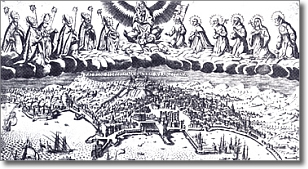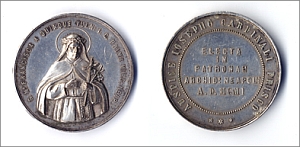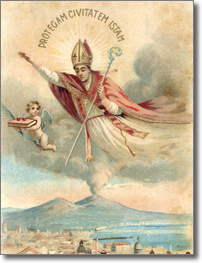With san Gennaro, patron saint of Naples par excellence, were named sant'Aspreno, sant'Atanasio, sant'Eufebio (also known as Efebo, turned by neapolitans into Eframo), sant'Agrippino and sant'Agnello abate.They were all named Bishops and the patrocinate of the city has been established in a so ancient epoch that it's unknown.
During 17th century the celestial designation of patron saints continued, thanks to an exploit of demands; during the Counter-Reformation, the protection of the city has been committed to 25 saints: s. Tommaso d'Aquino, s. Andrea d'Avellino, s. Patrizia, s. Francesco di Paola, s. Domenico, s. Giacomo della Marca, s. Francesco Saverio, s. Teresa d'Avila, s. Antonio di Padova, s. Filippo Neri, s. Gaetano, s. Severo, s. Nicola, s. Gregorio Armeno, s. Chiara, s. Biagio, s. Pietro martire, s. Giuseppe, s. Michele Arcangelo, s. Francesco d'Assisi, s. Maria Maddalena de' Pazzi, s. Giovanni Battista, s. Francesco Borgia, s. Candida minore, s. Maria Egiziaca.
In the age of Enlightenment the new patron saints were six:
s. Antonio Abate, s. Ignazio di Loyola, s. Maria Maddalena penitente, s. Irene, s. Emidio vescovo di Ascoli, s. Raffaele Arcangelo.
During the nineteenth century,ten:
s. Anna, s. Luigi Gonzaga, s. Agostino, s. Vincenzo Ferreri, s. Alfonso Maria de' Liguori, s. Francesco Caracciolo, s. Francesco de Geronimo (o de Girolamo, di Girolamo), s. Giovanni Giuseppe della Croce, s. Pasquale Baylon, s. Rocco, s. Gioacchino.
In the twentieth century only four: s. Maria Francesca delle Cinque Piaghe, s. Lucia, s. Gertrude, s. Rita.


